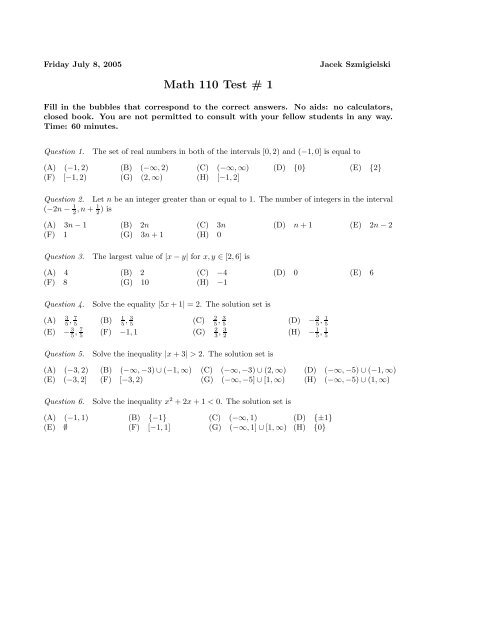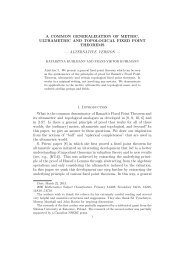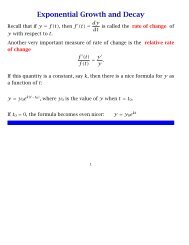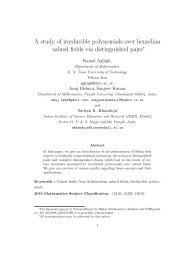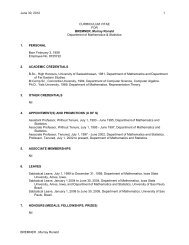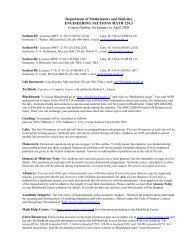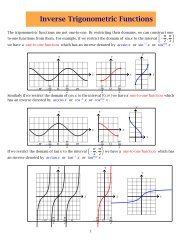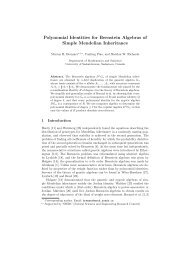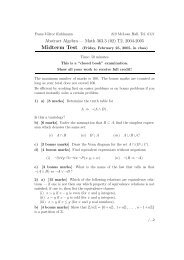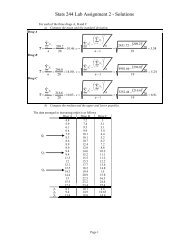Math 110 Test # 1
Math 110 Test # 1
Math 110 Test # 1
Create successful ePaper yourself
Turn your PDF publications into a flip-book with our unique Google optimized e-Paper software.
Friday July 8, 2005 Jacek Szmigielski<br />
<strong>Math</strong> <strong>110</strong> <strong>Test</strong> # 1<br />
Fill in the bubbles that correspond to the correct answers. No aids: no calculators,<br />
closed book. You are not permitted to consult with your fellow students in any way.<br />
Time: 60 minutes.<br />
Question 1. The set of real numbers in both of the intervals [0, 2) and (−1, 0] is equal to<br />
(A) (−1, 2) (B) (−∞, 2) (C) (−∞, ∞) (D) {0} (E) {2}<br />
(F) [−1, 2) (G) (2, ∞) (H) [−1, 2]<br />
Question 2. Let n be an integer greater than or equal to 1. The number of integers in the interval<br />
) is<br />
(−2n − 1 1<br />
2 , n + 2<br />
(A) 3n − 1 (B) 2n (C) 3n (D) n + 1 (E) 2n − 2<br />
(F) 1 (G) 3n + 1 (H) 0<br />
Question 3. The largest value of |x − y| for x, y ∈ [2, 6] is<br />
(A) 4 (B) 2 (C) −4 (D) 0 (E) 6<br />
(F) 8 (G) 10 (H) −1<br />
Question 4. Solve the equality |5x + 1| = 2. The solution set is<br />
(A) 3 7<br />
5 , 5 (B) 1 3<br />
5 , 5 (C) 2<br />
5<br />
(E) − 3 7<br />
5 , 5 (F) −1, 1 (G) 2<br />
3<br />
Question 5. Solve the inequality |x + 3| > 2. The solution set is<br />
, 3<br />
5 (D) − 3 1<br />
5 , 5<br />
2 (H) − 1 1<br />
5 , 5<br />
, 3<br />
(A) (−3, 2) (B) (−∞, −3) ∪ (−1, ∞) (C) (−∞, −3) ∪ (2, ∞) (D) (−∞, −5) ∪ (−1, ∞)<br />
(E) (−3, 2] (F) [−3, 2) (G) (−∞, −5] ∪ [1, ∞) (H) (−∞, −5) ∪ (1, ∞)<br />
Question 6. Solve the inequality x 2 + 2x + 1 < 0. The solution set is<br />
(A) (−1, 1) (B) {−1} (C) (−∞, 1) (D) {±1}<br />
(E) ∅ (F) [−1, 1] (G) (−∞, 1] ∪ [1, ∞) (H) {0}
Question 7. The set of x such that 0 < x < 2π and (1 + sin x)(x − 2) = 0 is<br />
(A) {−2π} (B) {2, −π} (C) ∅ (D) {2, π} (E) {π}<br />
(F) {2} (G) {2, π<br />
3π<br />
2 } (H) {2, 2 }<br />
Question 8. The length of the longest side in the triangle with vertices (0, 2), (−3, −1) and (1, −2)<br />
is<br />
(A) √ 14 (B) √ 15 (C) √ 16 (D) √ 17 (E) √ 18<br />
(F) √ 19 (G) √ 20 (H) √ 21<br />
Question 9. The value of m for which the lines 2x + 5y = 44 and mx − 4y = 55 are perpendicular<br />
is<br />
(A) 2<br />
2<br />
5<br />
5 (B) 10 (C) 44 (D)<br />
(F) π (G) − 5<br />
2 (H) −10<br />
44 (E) 1.5<br />
Question 10. The line going through the points (1.25, 2.9), (2.75, 5.9) has slope equal to<br />
(A) 1.5 (B) 1.75 (C) −3 (D) 2.75 (E) 2<br />
(F) 1.9 (G) −1.9 (H) 3<br />
Question 11. The value of tan 5π<br />
4 is<br />
1 (A) 1 (B) √2<br />
(C) − 1 √<br />
2<br />
1<br />
1<br />
(F) 2 (G) 2 (H) √3<br />
Question 12. The value of tan x if cos x = − 1<br />
3<br />
(A) 1 √3<br />
and π < x < 3π<br />
2 is<br />
(D) 0 (E) −1<br />
(B) √ 3<br />
3 (C) − √ 3 (D) 1 (E) −3<br />
(F) π (G) √ 5 (H) √ 8<br />
Question 13. If f(x) = 3x + 2 then the value of f(2) is<br />
(A) 2 (B) 0 (C) −2x − 8 (D) 6x + 4 (E) 4<br />
(F) 8 (G) −6 (H) 6<br />
Question 14. If f(x) = 3x + 2 then the set of x such that f(x) > −1 is<br />
(A) [ 1<br />
1<br />
1<br />
3 , ∞) (B) ( 3 , ∞) (C) [1, ∞) (D) [− 3 , ∞) (E) (−∞, ∞)<br />
, ∞) (G) [0, 1] (H) (−1, ∞)<br />
(F) (− 1<br />
3
y<br />
1<br />
1<br />
y=f(x)<br />
The remaining questions refer to the graph above, which is the graph of a function called f(x).<br />
Question 15. The domain of f is<br />
(A) ( 1<br />
2 , 2) (B) (−1, 3] (C) [−1, 1] (D) (−2, 3) (E) (−∞, ∞)<br />
, 2]<br />
(F) [0, 1] (G) [−2, 3] (H) [ 1<br />
2<br />
Question 16. The value of f(2) is<br />
(A) − 1<br />
1<br />
2 (B) −1 (C) 2 (D) 1 (E) 0<br />
(F) −2 (G) 2 (H) does not exist<br />
Question 17. The set of x such that f(x) ≥ 0 is<br />
(A) [−2, − 1<br />
1<br />
1<br />
2 ) ∪ [1, 3](B) (− 2 , 0) (C) [−2, − 2 ) ∪ (1, 3](D) [0, ∞) (E) (0, ∞)<br />
, 1]<br />
(F) (− 1<br />
1<br />
4 , 2] (G) (−∞, 0] (H) [− 2<br />
Question 18. The range of f is<br />
(A) (−∞, 0] (B) (−1, 2) (C) [−1, 2] (D) (−∞, ∞)<br />
(E) [−2, 1] (F) [2, ∞) (G) (−∞, −1) ∪ (2, ∞) (H) (−∞, −1] ∪ [2, ∞)<br />
Question 19. The set of x such that f(x) = 0 is<br />
(A) {0, − 1<br />
1<br />
1<br />
2 } (B) {1} (C) {− 2 1} (D) {0, 2<br />
(F) ∅ (G) {0} (H) (∞, ∞)<br />
Question 20. If f(x) = 1 and x < 1<br />
2 then x is<br />
x<br />
1<br />
, 1} (E) { 2 , 1}<br />
(A) −2 (B) − 1<br />
2 (C) 0, 1 (D) 3 (E) 0, 1, 3<br />
(F) 0 (G) 0, − 1<br />
2 (H) none<br />
Question 21. On exactly one of the following sets it is true that f is increasing. Which one?<br />
(A) [−2, 1] (B) [−2, 0] (C) [−1, 0] ∪ {2} (D) (−∞, ∞) (E) (0, ∞)<br />
, 1} (H) (−∞, 0)<br />
(F) ( 1<br />
1<br />
2 , 2) (G) { 2
Next 6 questions refer to the functions f(x) = √ x − 2 and g(x) = 3x − 2.<br />
Question 22. The value of (f + g)(6) is<br />
(A) 14 (B) 16 (C) 18 (D) 20 (E) 22<br />
(F) 24 (G) 26 (H) 28<br />
Question 23. The value of g ◦ f(11) is<br />
(A) 7 (B) √ 31 − 2 (C) 0 (D) √ 33 − 2 (E) 25<br />
(F) −13 (G) 10 (H) 22<br />
Question 24. The value of x such that f ◦ g(x) = g ◦ f(x) + 2 is<br />
(A) 7<br />
11<br />
7<br />
1<br />
3 (B) 3 (C) 12 (D) 3 (E) − 11<br />
3<br />
(F) 0 (G) − 7<br />
12 (H) 13<br />
Question 25. The domain of the function f<br />
g is<br />
(A) (−∞, − 2 2<br />
2<br />
) ∪ ( , ∞) (B) (−∞, ∞) (C) (−∞, −<br />
3<br />
(F) (−∞, − 2<br />
3<br />
3<br />
] ∪ ( 2<br />
3<br />
, ∞) (G) ( 2<br />
3<br />
, ∞) (H) [2, ∞)<br />
Question 26. The domain of the function f ◦ g is<br />
3<br />
2<br />
2<br />
) (D) [ 3 , ∞) (E) { 3 }<br />
(A) [ 4<br />
4<br />
3 , ∞) (B) (∞, ∞) (C) (−∞, 3 ] (D) [0, ∞) (E) (0, ∞)<br />
, ∞) (G) (−∞, 0) (H) (−∞, 0]<br />
(F) ( 4<br />
3<br />
Question 27. The value of f −1 (4) is<br />
(A) 14 (B) 16 (C) 18 (D) 20 (E) 22<br />
(F) 24 (G) 1<br />
2 (H) 1<br />
√2<br />
Question 28. The exact value of log9( 1<br />
3 ) is<br />
1<br />
(A) 3 (B) 2 (C) −3 (D) −2 (E) 3<br />
(F) − 1<br />
1<br />
3 (G) 2 (H) − 1<br />
2<br />
Question 29. The value of x for which 2 3x−2 = 5 is:<br />
1 3<br />
1 2<br />
1<br />
(A) log2 5 + 2 (B) 3 ln 5 − 2 (C) 3 ln 5 + 3 (D) 3 log2 1 (F) 3 log 2<br />
1<br />
1<br />
5 2 + 3 (G) 2 (H) √5 log2 5 + 2<br />
3<br />
Question 30. The exact value of 5 3 log 5 2−log 5 4+log 2 2 is<br />
2<br />
2<br />
5 + 3 (E) 3<br />
(A) 14 (B) 10 (C) 3 (D) 5 (E) 25<br />
(F) 2 (G) 1 (H) 5<br />
2<br />
Question 31. If the function f(x) = 232x then the inverse function f −1 (x) is:<br />
(A)<br />
(F)<br />
log2 x + log3 x<br />
log2 log3 x<br />
(B)<br />
(G)<br />
log2(log3 x)<br />
3x<br />
(C)<br />
(H)<br />
2 log3(log2 x)<br />
−<br />
(D) −2 log3(log2 x) (E)<br />
<br />
log3 log2 x<br />
3<br />
2 log2 x
¡<br />
¡<br />
¡£¢¥¤§¦©¨<br />
¨<br />
¡<br />
<br />
¡<br />
¨<br />
¡ <br />
¡<br />
¨<br />
The following questions refer to the above figure. Graph A of the figure is the graph of a function<br />
y = f(x), while the other graphs are graphs of y = a + bf(cx + d), for various values of a, b, c and d.<br />
Question 32. Graph B is the graph of the function<br />
¨<br />
¨<br />
¨<br />
(A) f(x − 4) (B) 4f(x) (C) f(−x) (D) f(−x) − 4 (E) f(x − 4) + 4<br />
(F) f(x + 4) (G) f(x) + 4 (H) f(4 − x)<br />
Question 33. Graph C is the graph of the function<br />
(A) f(x − 2) + 5 (B) f(x + 4) (C) 2f(x − 2) + 3 (D) 2f(x + 8) (E) 2f(x − 4)<br />
x − 8) (G) f(x − 4) (H) f(2x − 4)<br />
(F) f( 1<br />
2<br />
Question 34. Graph D is the graph of the function<br />
(A) f(−x) (B) f(x − 4) (C) f(x + 4) + 4 (D) −f(x) (E) f(x + 4)<br />
(F) f(x − 4) + 4 (G) f(x) + 4 (H) −f(−x) − 1<br />
Question 35. Graph E is the graph of the function<br />
(A) −f(x) (B) f(x − 4) (C) f(x + 4) + 4 (A) −f(x) (E) f(x + 4)<br />
(F) f(x − 4) + 4 (G) f(x) + 4 (H) −f(−x) − 1<br />
¡<br />
¡<br />
¡<br />
¨<br />
¨<br />
¨
Question 36. Graph F is the graph of the function<br />
1<br />
3<br />
(A) 2f(x + 2) +<br />
5<br />
f(x − 2) +<br />
(F) 1<br />
2<br />
1<br />
2 (B) f(x + 2) − 4 (C) 2<br />
1<br />
3<br />
2 (G) f(x) + 4 (H) 2f(x − 2) − 2<br />
5<br />
f(x + 2) + 2 (D) f(x − 2) + 4 (E) f(x − 2)


